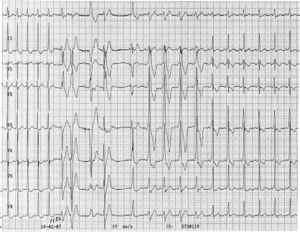Palpitations all the Time: Difference between revisions
Jump to navigation
Jump to search
m (New page: {{NHJ| |mainauthor= '''A.A.M. Wilde, R.B.A. van den Brink''' |edition= 2007:5,198 }} Figure 1|thumb A 14-year-old girl complained of palpitations that...) |
mNo edit summary |
||
| Line 19: | Line 19: | ||
[[Puzzle_2007_5_198_Answer|Answer]] | [[Puzzle_2007_5_198_Answer|Answer]] | ||
Revision as of 20:35, 8 October 2007
| Author(s) | A.A.M. Wilde, R.B.A. van den Brink | |
| NHJ edition: | 2007:5,198 | |
| These Rhythm Puzzles have been published in the Netherlands Heart Journal and are reproduced here under the prevailing creative commons license with permission from the publisher, Bohn Stafleu Van Loghum. | ||
| The ECG can be enlarged twice by clicking on the image and it's first enlargement | ||
A 14-year-old girl complained of palpitations that occurred numerous times a week. There were no special triggers and, usually, by deep breathing she was able to stop it. During one of the episodes she visited the emergency department. Physical examination revealed no abnormalities with exception of a fast regular pulse (185 beats/min). A deep breathhold did not stop the tachycardia this time and adenosine was administered intravenously. The ECG (leads I, II, V1 to V6) shortly after the bolus adenosine is shown in figure 1.
What is your diagnosis?
